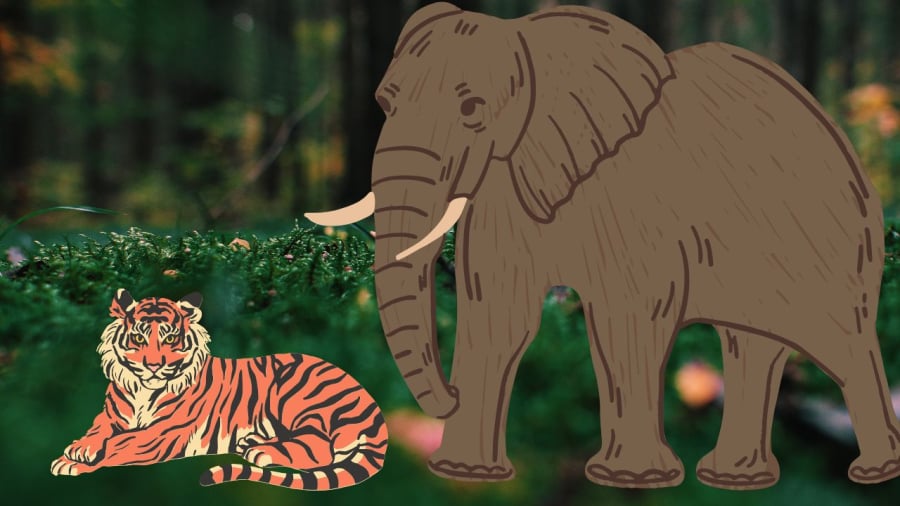The natural world presents an intriguing observation: numerous herbivorous animals boast significantly larger sizes compared to their carnivorous counterparts. Elephants, hippos, giraffes, buffaloes, and rhinos are prominent examples of herbivores with colossal physiques. Meanwhile, carnivores, despite their strength and ferocity, such as lions, tigers, leopards, and wolves, are noticeably smaller in stature. So, what drives this disparity in size between herbivores and carnivores? Let’s delve into the scientific reasons behind this captivating phenomenon.
1. Adaptive Defense Mechanisms
One of the primary reasons herbivores tend to be larger is to protect themselves from predators. Unlike carnivores, which are equipped with sharp claws and fangs, herbivores typically lack formidable offensive weapons. Hence, their larger body size serves as an effective defense strategy, making them less susceptible to attacks.

For instance, a fully grown elephant has almost no natural predators due to its massive weight, which can exceed 6 tons. Similarly, hippos, though not predators themselves, are among the most dangerous creatures in Africa, largely due to their size and powerful jaws. For herd-dwelling herbivores like buffaloes and antelopes, their larger frames instill confidence when confronting predators.
2. Specialized Digestive Systems and Dietary Requirements
Herbivores primarily consume plants, which are rich in fiber but offer lower energy content and are more challenging to digest than meat. To compensate for this, they need to eat large quantities daily. Larger body size translates to longer intestines and stomachs, facilitating more efficient digestion and enabling the storage of more food.
Creatures like cows, deer, and giraffes exemplify complex digestive systems with multiple compartments (such as the four-chambered stomach in cows) that aid in breaking down cellulose in grass. Moreover, to meet their constant dietary needs, herbivores typically spend a significant portion of their day grazing, which contributes to their overall size and mass development.
3. Survival Strategies and Reproductive Advantages
Larger sizes reduce predation rates among herbivores, leading to longer lifespans and improved reproductive prospects. Additionally, species with larger bodies tend to reproduce at lower frequencies but produce offspring with higher survival rates, thanks to the protection afforded by their parents and herds.
For instance, elephants have a gestation period of up to 22 months—the longest among animals—and usually give birth to a single calf. However, the substantial investment in each offspring and the robust defensive capabilities of adult elephants contribute to the stability of their populations over extended periods.
4. Distinct Social Structures
Carnivores like lions or wolves often hunt in small groups or as solitary individuals, negating the need for larger bodies. In contrast, herbivores tend to live in vast herds and travel tens of kilometers daily in search of food. Thus, their larger size enhances their efficiency in covering distances and storing energy during migrations through arid lands.
Furthermore, in the highly competitive world of herbivores, size confers an advantage in accessing food sources, especially for those that feed on high-growing foliage, such as giraffes.
5. Differential Evolutionary Pressures
The evolution of herbivores and carnivores follows distinct trajectories. Carnivores require speed, agility, and hunting skills, so they tend to maintain lighter bodies to enhance their pursuit and ambushing capabilities. Conversely, herbivores experience the pressure of surviving in the face of predators, driving their development of larger sizes and muscular strength as a defensive strategy.
Additionally, in the natural world, larger bodies bring physiological advantages, such as better thermoregulation, resilience to environmental changes, and the ability to travel longer distances while foraging or migrating seasonally.
Are Plant-Eaters Bigger Than Meat-Eaters?
1. Evolutionary Perspective: Humans as “Omnivores”
Humans are not strictly carnivores or herbivores but fall into the category of omnivores. This means that:
- Our dentition includes incisors, canines (for tearing meat), and molars (for grinding plant material).
- Our digestive system is long enough to handle plant material but not as long as that of strict herbivores.
- Our large brains evolved thanks to the energy derived from cooked meat (as per the “Cooking Hypothesis” by Richard Wrangham, Harvard).
Therefore, while meat consumption contributed to the evolution of our larger brains, it did not directly lead to larger bodies as observed in herbivores like elephants or deer.
2. Modern Perspective: Does Diet Influence Stature?
Yes, but it’s not the sole factor.
Research indicates that individuals following a well-planned vegetarian diet, with adequate nutrient intake (protein from beans, supplemented B12, iron, omega-3, etc.), do not suffer from stunted growth or malnutrition.
Conversely, those who consume meat but have an unbalanced diet (high in saturated fat and low in fruits and vegetables) may be prone to obesity and immune deficiencies.
A vegetarian or meat-based diet does not overtly determine human body size, unlike in the animal kingdom. Instead, genetic factors, adequate nutrition, physical activity, and environmental conditions predominantly influence height, weight, and overall health. However, a balanced diet, whether vegetarian or omnivorous, remains a prerequisite for optimal physical and cognitive development.

































